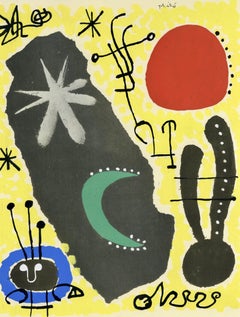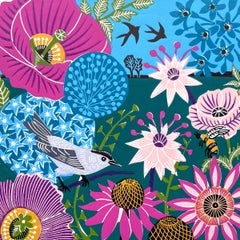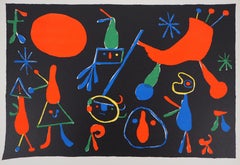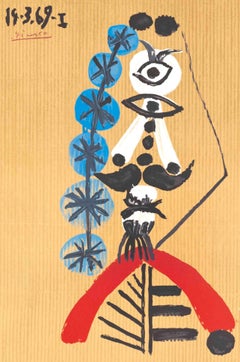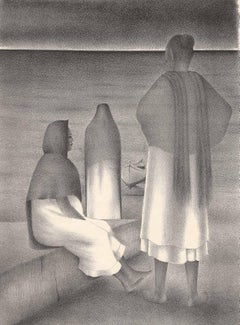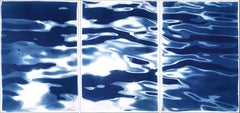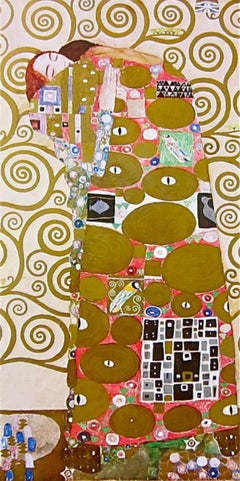Applique Landscape Prints
to
19
11
6
7
3
2
Overall Width
to
Overall Height
to
8
3
3
1
1
1
1
1
1
1
1
26
3
1
1
1
2
5
8
1
4
2
20
7
2
421
7,561
3,805
3,178
2,344
1,866
1,714
1,651
1,617
1,578
1,241
1,094
1,027
983
876
845
737
585
532
529
19
3
3
3
2
1
5
26
3
Art Subject: Applique
Papier collé, Société internationale d'art XXe siècle
By Joan Miró
Located in Auburn Hills, MI
Lithograph, stencil on vélin paper. Paper Size: 12.4 x 9.65 inches. Inscription: Signed in the plate and unnumbered, as issued. Notes: From the album, XXe siècle, Nouvelle série N° 6...
Category
1950s Surrealist Still-life Prints
Materials
Lithograph
$1,036 Sale Price
20% Off
Picasso, Composition (Orozco 207-261), Vingt-Neuf Portraits Imaginaires (after)
Located in Auburn Hills, MI
Lithograph on vélin d’Arches paper. Signed in the plate, as issued. Good condition. Notes: From the folio, Picasso, Vingt-Neuf Portraits Imaginaires, 1969. Published by Éditions Cerc...
Category
1960s Cubist Figurative Prints
Materials
Lithograph
$15,996 Sale Price
20% Off
Garden Blackcap
By Kate Heiss
Located in Deddington, GB
Garden Blackcap by Kate Heiss [2021]
limited_edition
Linocut
Edition number 30
Image size: H:30 cm x W:30 cm
Complete Size of Unframed Work: H:40 cm x W:40 cm x D:0.5cm
Sold Unframe...
Category
21st Century and Contemporary Pop Art Landscape Prints
Materials
Paper, Linocut
Miró, Composition, Cahiers d'Art (after)
By Joan Miró
Located in Auburn Hills, MI
Lithograph and stencil on vélin paper. Unsigned and unnumbered, as issued. Good condition. Notes: From the album, Cahiers d'Art N°24, 1949. Published and printed by Éditions des Cahi...
Category
1940s Modern Landscape Prints
Materials
Lithograph
$2,396 Sale Price
20% Off
"Paricutin (Volcano in Michoacan, Mexico)" Woodcut & Monotype signed by Summers
Located in Milwaukee, WI
"Paricutin (Volcano in Michoacan, Mexico)" is a woodcut and monotype signed by Carol Summers. In the image, an abstracted volcano erupts in a joyous burst of purples and oranges. The playfulness of the image is enhanced by Summers' signature printmaking technique, which allows the ink from the woodblock to seep through the paper, blurring the edges of each form.
Art: 8 x 11 in
Frame: 17 x 19 in
Carol Summers (1925-2016) has worked as an artist throughout the second half of the 20th century and into the first years of the next, outliving most of his mid-century modernist peers. Initially trained as a painter, Summers was drawn to color woodcuts around 1950 and it became his specialty thereafter. Over the years he has developed a process and style that is both innovative and readily recognizable. His art is known for it’s large scale, saturated fields of bold color, semi-abstract treatment of landscapes from around the world and a luminescent quality achieved through a printmaking process he invented.
In a career that has extended over half a century, Summers has hand-pulled approximately 245 woodcuts in editions that have typically run from 25 to 100 in number. His talent was both inherited and learned. Born in 1925 in Kingston, a small town in upstate New York, Summers was raised in nearby Woodstock with his older sister, Mary. His parents were both artists who had met in art school in St. Louis. During the Great Depression, when Carol was growing up, his father supported the family as a medical illustrator until he could return to painting. His mother was a watercolorist and also quite knowledgeable about the different kinds of papers used for various kinds of painting. Many years later, Summers would paint or print on thinly textured paper originally collected by his mother.
From 1948 to 1951, Carol Summers trained in the classical fine and studio arts at Bard College and at the Art Students League of New York. He studied painting with Steven Hirsh and printmaking with Louis Schanker. He admired the shapes and colors favored by early modernists Paul Klee (Sw: 1879-1940) and Matt Phillips (Am: b.1927- ). After graduating, Summers quit working as a part-time carpenter and cabinetmaker (which had supported his schooling and living expenses) to focus fulltime on art. That same year, an early abstract, Bridge No. 1 was selected for a Purchase Prize in a competition sponsored by the Brooklyn Museum.
In 1952, his work (Cathedral, Construction and Icarus) was shown the first time at the Museum of Modern Art in New York City in an exhibition of American woodcuts. In 1954, Summers received a grant from the Italian government to study for a year in Italy. Woodcuts completed soon after his arrival there were almost all editions of only 8 to 25 prints, small in size, architectural in content and black and white in color. The most well-known are Siennese Landscape and Little Landscape, which depicted the area near where he resided. Summers extended this trip three more years, a decision which would have significant impact on choices of subject matter and color in the coming decade.
After returning from Europe, Summers’ images continued to feature historical landmarks and events from Italy as well as from France, Spain and Greece. However, as evidenced in Aetna’s Dream, Worldwind and Arch of Triumph, a new look prevailed. These woodcuts were larger in size and in color. Some incorporated metal leaf in the creation of a collage and Summers even experimented with silkscreening. Editions were now between 20 and 50 prints in number. Most importantly, Summers employed his rubbing technique for the first time in the creation of Fantastic Garden in late 1957.
Dark Vision of Xerxes, a benchmark for Summers, was the first woodcut where Summers experimented using mineral spirits as part of his printmaking process. A Fulbright Grant as well as Fellowships from the Louis Comfort Tiffany Foundation and the Guggenheim Foundation followed soon thereafter, as did faculty positions at colleges and universities primarily in New York and Pennsylvania. During this period he married a dancer named Elaine Smithers with whom he had one son, Kyle. Around this same time, along with fellow artist Leonard Baskin, Summers pioneered what is now referred to as the “monumental” woodcut. This term was coined in the early 1960s to denote woodcuts that were dramatically bigger than those previously created in earlier years, ones that were limited in size mostly by the size of small hand-presses. While Baskin chose figurative subject matter, serious in nature and rendered with thick, striated lines, Summers rendered much less somber images preferring to emphasize shape and color; his subject matter approached abstraction but was always firmly rooted in the landscape.
In addition to working in this new, larger scale, Summers simultaneously refined a printmaking process which would eventually be called the “Carol Summers Method” or the “ Carol Summers Technique”. Summers produces his woodcuts by hand, usually from one or more blocks of quarter-inch pine, using oil-based printing inks and porous mulberry papers. His woodcuts reveal a sensitivity to wood especially its absorptive qualities and the subtleties of the grain. In several of his woodcuts throughout his career he has used the undulating, grainy patterns of a large wood plank to portray a flowing river or tumbling waterfall. The best examples of this are Dream, done in 1965 and the later Flash Flood Escalante, in 2003. In the majority of his woodcuts, Summers makes the blocks slightly larger than the paper so the image and color will bleed off the edge.
Before printing, he centers a dry sheet of paper over the top of the cut wood block or blocks, securing it with giant clips. Then he rolls the ink directly on the front of the sheet of paper and pressing down onto the dry wood block or reassembled group of blocks. Summers is technically very proficient; the inks are thoroughly saturated onto the surface of the paper but they do not run into each other. The precision of the color inking in Constantine’s Dream in 1969 and Rainbow Glacier in 1970 has been referred to in various studio handbooks. Summers refers to his own printing technique as “rubbing”. In traditional woodcut printing, including the Japanese method, the ink is applied directly onto the block. However, by following his own method, Summers has avoided the mirror-reversed image of a conventional print and it has given him the control over the precise amount of ink that he wants on the paper. After the ink is applied to the front of the paper, Summers sprays it with mineral spirits, which act as a thinning agent. The absorptive fibers of the paper draw the thinned ink away from the surface softening the shapes and diffusing and muting the colors. This produces a unique glow that is a hallmark of the Summers printmaking technique. Unlike the works of other color field artists or modernists of the time, this new technique made Summers’ extreme simplification and flat color areas anything but hard-edged or coldly impersonal.
By the 1960s, Summers had developed a personal way of coloring and printing and was not afraid of hard work, doing the cutting, inking and pulling himself. In 1964, at the age of 38, Summers’ work was exhibited for a second time at the Museum of Modern Art. This time his work was featured in a one-man show and then as one of MoMA’s two-year traveling exhibitions which toured throughout the United States. In subsequent years, Summers’ works would be exhibited and acquired for the permanent collections of multiple museums throughout the United States, Europe and Asia. Summers’ familiarity with landscapes throughout the world is firsthand. As a navigator-bombardier in the Marines in World War II, he toured the South Pacific and Asia.
Following college, travel in Europe and subsequent teaching positions, in 1972, after 47 years on the East Coast, Carol Summers moved permanently to Bonny Doon in the Santa Cruz Mountains in Northern California. There met his second wife, Joan Ward Toth, a textile artist who died in 1998; and it was here his second son, Ethan was born. During the years that followed this relocation, Summers’ choice of subject matter became more diverse although it retained the positive, mostly life-affirming quality that had existed from the beginning. Images now included moons, comets, both sunny and starry skies, hearts and flowers, all of which, in one way or another, remained tied to the landscape.
In the 1980s, from his home and studio in the Santa Cruz mountains, Summers continued to work as an artist supplementing his income by conducting classes and workshops at universities in California and Oregon as well as throughout the Mid and Southwest. He also traveled extensively during this period hiking and camping, often for weeks at a time, throughout the western United States and Canada. Throughout the decade it was not unusual for Summers to backpack alone or with a fellow artist into mountains or back country for six weeks or more at a time. Not surprisingly, the artwork created during this period rarely departed from images of the land, sea and sky. Summers rendered these landscapes in a more representational style than before, however he always kept them somewhat abstract by mixing geometric shapes with organic shapes, irregular in outline. Some of his most critically acknowledged work was created during this period including First Rain, 1985 and The Rolling Sea, 1989. Summers received an honorary doctorate from his alma mater, Bard College in 1979 and was selected by the United States Information Agency to spend a year conducting painting and printmaking workshops at universities throughout India. Since that original sabbatical, he has returned every year, spending four to eight weeks traveling throughout that country.
In the 1990s, interspersed with these journeys to India have been additional treks to the back roads and high country areas of Mexico, Central America, Nepal, China and Japan. Travel to these exotic and faraway places had a profound influence on Summers’ art. Subject matter became more worldly and non-western as with From Humla to Dolpo, 1991 or A Former Life of Budha, 1996, for example. Architectural images, such as The Pillars of Hercules, 1990 or The Raja’s Aviary, 1992 became more common. Still life images made a reappearance with Jungle Bouquet in 1997. This was also a period when Summers began using odd-sized paper to further the impact of an image.
The 1996 Night, a view of the earth and horizon as it might be seen by an astronaut, is over six feet long and only slightly more than a foot-and-a-half high. From 1999, Revuelta A Vida (Spanish for “Return to Life”) is pie-shaped and covers nearly 18 cubic feet. It was also at this juncture that Summers began to experiment with a somewhat different palette although he retained his love of saturated colors. The 2003 Far Side of Time is a superb example of the new direction taken by this colorist.
At the turn of the millennium in 1999, “Carol Summers Woodcuts...
Category
Early 2000s Contemporary Landscape Prints
Materials
Monotype, Woodcut
Picasso, Composition (Orozco 207-261), Vingt-Neuf Portraits Imaginaires (after)
Located in Auburn Hills, MI
Lithograph on vélin d’Arches paper. Signed in the plate, as issued. Good condition. Notes: From the folio, Picasso, Vingt-Neuf Portraits Imaginaires, 1969. Published by Éditions Cerc...
Category
1960s Cubist Figurative Prints
Materials
Lithograph
$15,996 Sale Price
20% Off
Original "Student Winter in Poland with Amatur" vintage travel and ski poster
Located in Spokane, WA
Original “Student Winter in Poland with Almatur” horizontal Polish poster. Travel and tourism office of the Socialist Union of Polish Students”. Th...
Category
1970s Post-Modern Figurative Prints
Materials
Offset
The Bird, School Prints, Georges Braque
Located in Auburn Hills, MI
Lithograph on English cartridge paper. Inscription: Unsigned and unnumbered, as issued. Good Condition; never framed or matted. Notes: Published by School Prints Ltd., London; Printe...
Category
1940s Modern Landscape Prints
Materials
Lithograph
$2,556 Sale Price
20% Off
Matisse, Poisson chinois (Duthuit 139), Verve: Revue Artistique (after)
Located in Auburn Hills, MI
Lithograph on vélin du Marais paper. Inscription: Unsigned and unnumbered, as issued. Good condition. Notes: From the volume, Verve: Revue Artistique et Littéraire, Vol. IX, N° 35-36...
Category
1950s Modern Landscape Prints
Materials
Lithograph
$956 Sale Price
20% Off
Klimt, Die Freundinnen, Das Werk von Gustav Klimt (after)
By Gustav Klimt
Located in Auburn Hills, MI
Héliogravure, collotype vélin paper. Paper Size: 18.23 x 17.32 inches; image size: 12.64 x 5 inches. Inscription: Signed in the plate and unnumbered, as issued. Notes: From the folio...
Category
1910s Symbolist Figurative Prints
Materials
Lithograph
$27,996 Sale Price
20% Off
Seascape - Etching by Alcione Gubellini - Mid-20th Century
Located in Roma, IT
Etching and drypoint realized by Alcione Gubellini in the mid-20th Century.
Edition of 16.
Hand signed and numbered in pencil.
Excellent condition.
Category
Mid-20th Century Modern Landscape Prints
Materials
Etching
Castle, Aquatint Etching by Keiko Minami
By Keiko Minami
Located in Long Island City, NY
Artist: Keiko Minami, Japanese (1911 - 2004)
Title: Castle
Year: circa 1985
Medium: Aquatint Etching, Signed and numbered in pencil
Edition: 120
Image Size: 12 x 11 inches
Size: 22 ...
Category
1980s Folk Art Landscape Prints
Materials
Etching, Aquatint
Ernst, Composition (Monod 2619; Spies/Leppien A19/C), Dent Prompte (after)
By Max Ernst
Located in Auburn Hills, MI
Lithograph on vélin d’Arches paper. Inscription: unsigned and unnumbered, as issued. Good condition. Notes: From the folio, Dent Prompte, Dix poèmes inédits illustrés par Max Ernst, ...
Category
1960s Surrealist Landscape Prints
Materials
Lithograph
$716 Sale Price
52% Off
Papier collé, Société internationale d'art XXe siècle
Located in Auburn Hills, MI
Lithograph, stencil on vélin paper. Paper Size: 12.4 x 9.65 inches. Inscription: Signed in the plate and unnumbered, as issued. Notes: From the album, XXe siècle, Nouvelle série N° 6...
Category
1950s Cubist Still-life Prints
Materials
Lithograph
$796 Sale Price
20% Off
Picasso, Composition (Cramer 15; Bloch 56), Picasso, Oeuvres 1920-1926 (after)
Located in Auburn Hills, MI
Lithograph and stencil on vélin paper. Unsigned and unnumbered, as issued. Good condition. Notes: From the album, Picasso, Oeuvres 1920-1926, 1926. Published and printed by Éditions ...
Category
1920s Cubist Still-life Prints
Materials
Lithograph, Stencil
$2,396 Sale Price
20% Off
Klimt, Die Umarmung, Gustav Klimt, Eine Nachlese (after)
By Gustav Klimt
Located in Auburn Hills, MI
Héliogravure, collotype, metallic inks on vélin paper. Paper Size: 18.86 x 17.91 inches; image size: 12.24 x 7.6 inches. Inscription: Signed in the plate and unnumbered, as issued. N...
Category
1930s Symbolist Figurative Prints
Materials
Lithograph
$19,996 Sale Price
20% Off
Picasso, Composition (Orozco 207-261), Vingt-Neuf Portraits Imaginaires (after)
Located in Auburn Hills, MI
Lithograph on vélin d’Arches paper. Signed in the plate, as issued. Good condition. Notes: From the folio, Picasso, Vingt-Neuf Portraits Imaginaires, 1969. Published by Éditions Cerc...
Category
1960s Cubist Figurative Prints
Materials
Lithograph
$15,996 Sale Price
20% Off
Toulouse-Lautrec, Composition, Les Affiches De Toulouse-Lautrec (after)
Located in Fairfield, CT
Medium: Lithograph on grand vélin Filigrané a sa marque paper
Year: 1950
Paper Size: 12.5 x 9.75 inches; image size: 11.02 x 7.87 inches
Inscription: Signed in the plate and unnumber...
Category
1950s Post-Impressionist Figurative Prints
Materials
Lithograph
$716 Sale Price
20% Off
Picasso, Composition (Orozco 207-261), Vingt-Neuf Portraits Imaginaires (after)
Located in Auburn Hills, MI
Lithograph on vélin d’Arches paper. Signed in the plate, as issued. Good condition. Notes: From the folio, Picasso, Vingt-Neuf Portraits Imaginaires, 1969. Published by Éditions Cerc...
Category
1960s Cubist Figurative Prints
Materials
Lithograph
$15,996 Sale Price
20% Off
Picasso, Composition (Orozco 207-261), Vingt-Neuf Portraits Imaginaires (after)
Located in Auburn Hills, MI
Lithograph on vélin d’Arches paper. Signed in the plate, as issued. Good condition. Notes: From the folio, Picasso, Vingt-Neuf Portraits Imaginaires, 1969. Published by Éditions Cerc...
Category
1960s Cubist Figurative Prints
Materials
Lithograph
$15,996 Sale Price
20% Off
La Vierge (Virgo), Les Signes du zodiaque, Jean Lurçat
By Jean Lurçat
Located in Auburn Hills, MI
Lithograph on vélin d'Arches paper. Unsigned and unnumbered, as issued. Good Condition; never framed or matted. Notes: From the folio, Les Signes du zodiaque, 1959. Published by Édit...
Category
1950s Modern Landscape Prints
Materials
Lithograph
$716 Sale Price
34% Off
Leonard Paris vintage 100% silk scarf, floral on red ground. Excellent condition
Located in Bryn Mawr, PA
Vintage Leonard of Paris 100% silk scarf, warm-toned flowers on vivid red ground. "Leonard" designer printed along lower edge and also within the floral design itself. 27" x 27", ca....
Category
1980s Modern Still-life Prints
Materials
Silk
Christmas Wishes Card - Vintage Postcard - 1968
Located in Roma, IT
Christmas wishes card - is a colored vintage postcard realized in December 1968, for Christmas wishes.
Good conditions and aged.
It belongs to a historical and nostalgic album inc...
Category
1960s Modern Landscape Prints
Materials
Paper, Postcard
Ernst, Composition (Monod 2619; Spies/Leppien A19/C), Dent Prompte (after)
By Max Ernst
Located in Auburn Hills, MI
Lithograph on vélin d’Arches paper. Inscription: unsigned and unnumbered, as issued. Good condition. Notes: From the folio, Dent Prompte, Dix poèmes inédits illustrés par Max Ernst, ...
Category
1960s Surrealist Landscape Prints
Materials
Lithograph
$716 Sale Price
52% Off
Past and Present, Lithograph by Remo Farruggio
Located in Long Island City, NY
Past and Present
Remo Farruggio, Italian/American (1904–1981)
Date: Circa 1979
Lithograph, signed and numbered in pencil
Edition of 300, AP 35
Image Size: 20.5 x 28 inches
Size: 27 i...
Category
1980s American Modern Landscape Prints
Materials
Lithograph
Waterdrops, Lithograph by Kim Tschang-Yeul
Located in Long Island City, NY
Artist: Tschang-Yeul Kim, Korean (1929 - )
Title: Water Drops
Year: 1988
Medium: Screenprint, signed and numbered in pencil
Edition: 300
Size: 43.5 in. x 29 in. (110.49 cm x 73.66 cm)
Category
1980s Conceptual Landscape Prints
Materials
Screen
Aunt Sue's Stories, Sunrise Is Coming After While
Located in Auburn Hills, MI
Silkscreen on vélin d’Arches paper. Paper Size: 14 x 11 inches. Inscription: Unsigned and unnumbered, as issued. Notes: From the folio, Bookmarks in the Pages of Life, 1998. Published by The Limited Editions Club, New York; printed by Drexel Press, Inc. Long Island City, 1998. Excerpted from the folio, CCC examples, designed, hand-set in Monotype Perpetua, printed, and hand-bound by Michael and Winifred Bixler, Skaneateles, New York. Paper made in France at Arches. Silkscreens printed by the Drexel Press, Inc. Long Island City, New York.
PHOEBE BEASLEY...
Category
1990s Expressionist Figurative Prints
Materials
Screen
$4,796 Sale Price
20% Off
Donald Baechler Sea World 1999 (Donald Baechler prints)
Located in NEW YORK, NY
Donald Baechler, Sea World, 1999:
A fun, whimsical, and highly decorative signed limited edition Baechler piece that works well in any setting.
Medium: Soft-ground etching and aqu...
Category
1990s Contemporary Animal Prints
Materials
Etching, Aquatint, Lithograph, Screen
NoWizardBehindTheCurtain (pattern, abstract, blues, organic, chine colle)
Located in New York, NY
Mixed Media Paper Composite Fused on and behind BFK Rives Printmaking Paper Acrylic, Oil Paint with Sumi Ink Painting and Drawing on Glassine Sheet, Overlaid with Mylar, Ink Lines a...
Category
2010s Contemporary Landscape Prints
Materials
Paper, Sumi Ink, Mixed Media, Oil
Related Items
La Espera (The Wait -- Three Women by the sea)
Located in New Orleans, LA
The Wait. Three native Mexican women wait by the sea. This impression is #31/100. An impression of this lithograph is in the permanent collectio...
Category
Mid-20th Century Modern Figurative Prints
Materials
Lithograph
$506 Sale Price
40% Off
H 18 in W 14 in
Venice Seascape Triptych, Blue Lido Island Reflections, Contemporary Cyanotype
By Kind of Cyan
Located in Barcelona, ES
This series of cyanotype triptychs showcases the beauty of nature scenes, including stunning beaches and oceans, as well as the intricate textures of water, forests, and skies. These...
Category
2010s Contemporary Abstract Prints
Materials
Lithograph, Monotype, Paper
$744 Sale Price
20% Off
H 40 in W 83 in
Golden Gate Bridge, San Francisco
Located in San Francisco, CA
This artwork titled "Golden Gate Bridge, San Francisco" 1988 is a original colors lithograph on Arches paper by French artist (Fanch, Francois Ledan, born 1949) It is hand signed and inscribed A.P. (Artist Proof) in pencil by the artist. The image size is 26 x 19.5 inches, framed is 37.25 x 31.25 inches. Published and printed by Art Estampes, Paris. Custom framed in a wooden gold frame, with off white matting. It is in excellent condition, the frame has a minor restoration at the lower right side corner, practically invisible.
About the artist:
Francois "Fanch" Ledan (b. 1949) is noted for colorful scenes of his native Brittany. In 1968 he abandoned his studies in commercial design for full-time studies in painting and fine art. His talent was quickly recognized and soon he was involved in major European shows. He became involved in printmaking in 1973 when he learned lithography in Paris. Since then he has had numerous one-person shows in Europe, North America and South America.
His paintings and lithographs from the 1970's and 1980's display characteristics often associated with "naïve" art. His views of Paris, a city which has embraced naïve art, display the attention to detail,
In the 80's he turned to more brightly colored paintings and again a connection to Impressionism. He began to work on paintings that he refers to as "interiorscapes" or "interior visions...
Category
Late 20th Century Modern Landscape Prints
Materials
Lithograph
Untitled
Located in San Francisco, CA
Artist: Billy Al Bengston – American (1934-2022)
Title: Untitled
Year: 1990
Medium: Lithograph, silkscreen on Arches paper
Sight size: 19.5 x 25.5 inches.
Sheet size: 24 x 30 inches.
Signature: Signed lower right
Publisher: Cirrus Editions, Ltd., Los Angeles, CA
Edition: 250 This one: 120/250
Condition: Excellent
This print is by Billy Al Bengston. It depicts what looks like a coyote staring out at the horizon on a full moon night. This print was created at the same time Bengston was creating his Moon paintings. The print has dark colors. As a result, my photographs are imperfect; they have a bit of glare. The print is in excellent condition. It is attached by two hinges to a matboard measuring 26 x 32 inches and has a Plexiglas frame. The frame is in fair condition with some light scratches.
Billy Al Bengston (June 7, 1934 – October 8, 2022) was an American visual artist and sculptor who lived and worked in Venice, California, and Honolulu, Hawaii. Bengston was probably best known for work he created that reflected California's "Kustom" car and motorcycle culture. He pioneered the use of sprayed layers of automobile lacquer in fine art and often used colors that were psychedelic and shapes that were mandala-like. ARTnews referred to Bengston as a "giant of Los Angeles's postwar art scene."
Early life and education
Bengston was born in Dodge City, Kansas, on June 7, 1934. His family relocated to Los Angeles in 1948. He attended Los Angeles City College in 1952. Subsequently, he studied painting under Richard Diebenkorn and Saburo Hasegawa at the California College of Arts and Crafts, in Oakland, California, in 1955 and returned to Los Angeles to study at Otis Art Institute in 1956.
Career
Bengston began showing with the Ferus Gallery in Los Angeles (founded and run by Walter Hopps and Edward Kienholz, and later Irving Blum), having five shows between 1958 and 1963. As a fixture at the gallery, he was among a cohort of artists that included Kienholz, Ed Ruscha, Larry Bell, Kenneth Price, Ed Moses, and Robert Irwin. (The gallery closed in 1966.) In a 2018 article in Vanity Fair, Bengston recalled that he and Irwin hung the 32 pieces in Andy Warhol's Campbell's soup-can paintings show at Ferus in 1962. He notably described the atmosphere of Ferus as a "macho intellectual gang bang".
After seeing the work of Jasper Johns at the 1958 Venice Biennale he adopted the motif of a set of sergeant's stripes. This recurring chevron image was painted with industrial materials and techniques associated with the decoration of motorcycle fuel tanks and surfboards. According to Grace Glueck of The New York Times, Bengston "was among the first to ditch traditional oil paint on canvas, opting instead for sprayed layers of automobile lacquer on aluminum in soft colors, achieving a highly reflective, translucent surface."
Bengston encouraged viewers in the early 1960s to associate his art with motorcycle subculture; on the cover of a 1961 catalogue for a Ferus show, he was seen straddling a motorcycle. (He also competed in motocross competitions.) "When I painted these motorcycle paintings...
Category
1990s Pop Art Animal Prints
Materials
Paper, Lithograph, Screen
"Full Cry" - Mid Century Horse Hunt Figurative Landscape
Located in Soquel, CA
A dynamic mid 20th century copy of a lithograph that depicts Englishmen on horseback giving chase with a pack of beagle-type dogs running in the background. by John Frederick Herring...
Category
1960s Romantic Landscape Prints
Materials
Offset, Paper
$396 Sale Price
20% Off
H 20.75 in W 28.25 in D 1.5 in
LOBSTER and OCTOPUS (KAMPF - BATTLE)
Located in Santa Monica, CA
NORBERTINE VON BRESSLERN-ROTH (1891 1978)
KAMPF (BATTLE - LOBSTER and OCTOPUS) c. 1928
Color linoleum cut Signed in pencil. Image 8 5/8 x 8 11/16”
In excellent condition and full ...
Category
1920s Vienna Secession Animal Prints
Materials
Linocut
Mexican Travelers, Modern Lithograph by Millard Sheets
Located in Long Island City, NY
Mexican Travelers by Millard Owen Sheets, American (1907–1989)
Date: Circa 1977
Lithograph on Arches paper, signed and numbered in pencil
Edition o...
Category
1970s American Modern Landscape Prints
Materials
Lithograph
$1,200
H 24 in W 35 in
In the Garden, Color Lithograph, XV/LXXV, Figure, Flowers, France
Located in Wiscasset, ME
Jean-Pierre Cassigneul was born in 1935 and first exhibited his work at age 17. He went on to participate in various group exhibitions, including the Salon d’Automne in Paris, the Sa...
Category
20th Century Modern Figurative Prints
Materials
Lithograph
$1,400
H 23.5 in W 17.5 in
Le Lapin Agile
Located in San Francisco, CA
This artwork "Le Lapin Agile" c.1970 Is an original colors lithograph by noted French artist Denis Paul Noyer, b.1940. It is signed and numbered 372/375 in...
Category
Late 20th Century Modern Figurative Prints
Materials
Lithograph
The Hunters
Located in Belgrade, MT
This piece is artist signed and numbered. Jacques Despierre was born in St. Etienne France, 1912-1995. He studied at the Academie Colarrossi and also at the Ecole des Beaux arts in P...
Category
Early 20th Century Cubist Figurative Prints
Materials
Paint, Lithograph
Low Tide
Located in San Francisco, CA
This artwork titled "Low Tide" 1943 is an original lithograph by New York artist Julian Edwin Levi, 1900-1982. It is hand signed in pencil by the art...
Category
Mid-20th Century American Modern Figurative Prints
Materials
Lithograph
Royal Hotel - New Orleans 1920s Depression Art Lithograph in Ink on Paper
Located in Soquel, CA
Royal Hotel - New Orleans 1920s Depression Art Lithograph in Ink on Paper
Dramatic street scene with a man wearing a trench coat and hat by Robert J We...
Category
Late 20th Century American Modern Landscape Prints
Materials
Paper, Lithograph
$975
H 20 in W 16 in D 0.25 in
Previously Available Items
Klimt, Fulfillment
By Gustav Klimt
Located in Auburn Hills, MI
GUSTAV KLIMT (1862-1918) Austrian symbolist painter and one of the most prominent members of the Vienna Secession movement. Klimt is noted for his paintings, murals, sketches, and ot...
Category
1980s Post-Impressionist Figurative Prints
Materials
Offset
